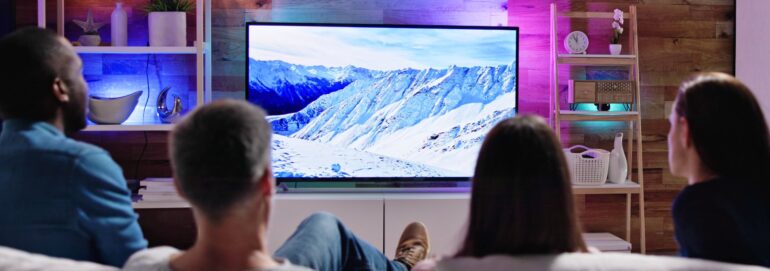How bright is the designated “TV room”?
Experience has shown that little or no importance is initially attributed to the issue of room brightness. However, the illumination of the “TV room” plays a decisive role in connection with the performance of the TV of your choice. In the following sections, we will explain what you should look out for when making your purchase decision and why OLED and LED models differ greatly in this respect in particular.
Depending on the price range, televisions are not only defined by their color space, range of functions and connection standards, but also by their individual brightness performance. To deal with this point only in passing does not do justice to the current situation on the TV market. While LED-LCD models actually play a subordinate role here, OLED devices are the thematically interesting crux of our analysis.
This is because what is usually concealed from laypeople is the aspect that is still relevant today with regard to the importance of screen brightness in everyday use. However, this point is consistently ignored by manufacturers and retailers. As expected, marketing departments only sell the customer, let’s say, the part of the information that relates to the best possible brightness characteristics of a TV set, without mentioning the “small print”, so to speak.
OLEDs lag behind when it comes to surface brightness

Even well-known technology portals pass around one test device after another at this point and gloss over what cannot be glossed over. While current top-of-the-line OLEDs for the average consumer may have significantly narrowed the gap to LED LCDs in terms of peak brightness, this clearly does not apply to full-surface brightness.
Especially as models with backlighting are of course also becoming brighter and reaching measured values of 700, 800 or 900 cd/m². In addition, there is a significantly lower limitation due to the automatic brightness control – see ABL.
For comparison: upper-class models with panels based on self-illuminating pixels are currently predominantly in measurement ranges of around 200 candela per square meter, or cd/m² for short. Even TVs from LG’s popular C-series only come close to these figures with 150 – 160 cd/m². A Samsung S95D QD-OLED from 2024 at least scratches the 300 cd/m² mark.
What is particularly interesting is that while the maximum luminance performance of OLEDs has regularly increased over the past few years, not much has actually happened with the equally important value of surface brightness.
On the contrary: depending on the line-up strategy, manufacturersare reducing performance – as with the leap from the LG OLED B2 to the B3 series – or virtually freezing performance. One example of this is the LG OLED evo G4. Compared to its predecessor, the 2024 model offers little improvement here. Blind faith is therefore no longer the order of the day. This makes thorough research all the more important.
OLED or LED: Which solution is best for your “TV room”?
If you bear in mind that LED-LCD televisions can sometimes be much brighter, you should clarify seven key points when making your decision.
- Does the room have large window fronts, which in unfavorable cases may even be positioned in front of the screen and could cause annoying reflections?
- Is the room generally very brightly lit during the day due to sunlight?
- Do you typically watch with the light on?
- Would the TV be used frequently during the day after purchase?
- Can the light be dimmed effectively if necessary or could you achieve complete dimming in the best case scenario?
- Do you really want to darken the room – if necessary – every time?
- Would it be possible to install a swivelling wall bracket to minimize or completely avoid reflections, sun or other light sources?
What about direct sunlight?

You should avoid direct sunlight on the screen with all televisions! This issue is often played down. However, even a small amount of light for a few minutes a day can be enough to cause increased wear, which can have a negative effect on the display quality within a short time. A certain amount of caution is therefore required in order to avoid a lot of shouting and possible complaints afterwards.
To explain: OLED models use organic material that is affected by UV radiation and heat development and can therefore wear out more quickly. Permanent burning – known as burn-in – is also favored here. Another point is recalibration in standby mode. If sunlight falls on the panel during this maintenance process, the change in temperature causes measurement deviations that can lead to extremely unsightly spots on the display.
LED LCDTVs use so-called diffuser foils, also known as light guides, which perform a scattering function so that the screen is illuminated more evenly. Depending on the efficiency of the TV’s heat dissipation, the sun’s rays can cause these layers to peel off or stretch, thus promoting the formation of image errors. You should pay particular attention to this in attic and maisonette apartments, as heat can build up here – especially in summer – and the room temperature is already high.
Do you think we’ve missed something important here or do you have any other interesting suggestions on this topic? We welcome any constructive suggestions in the comments section.







